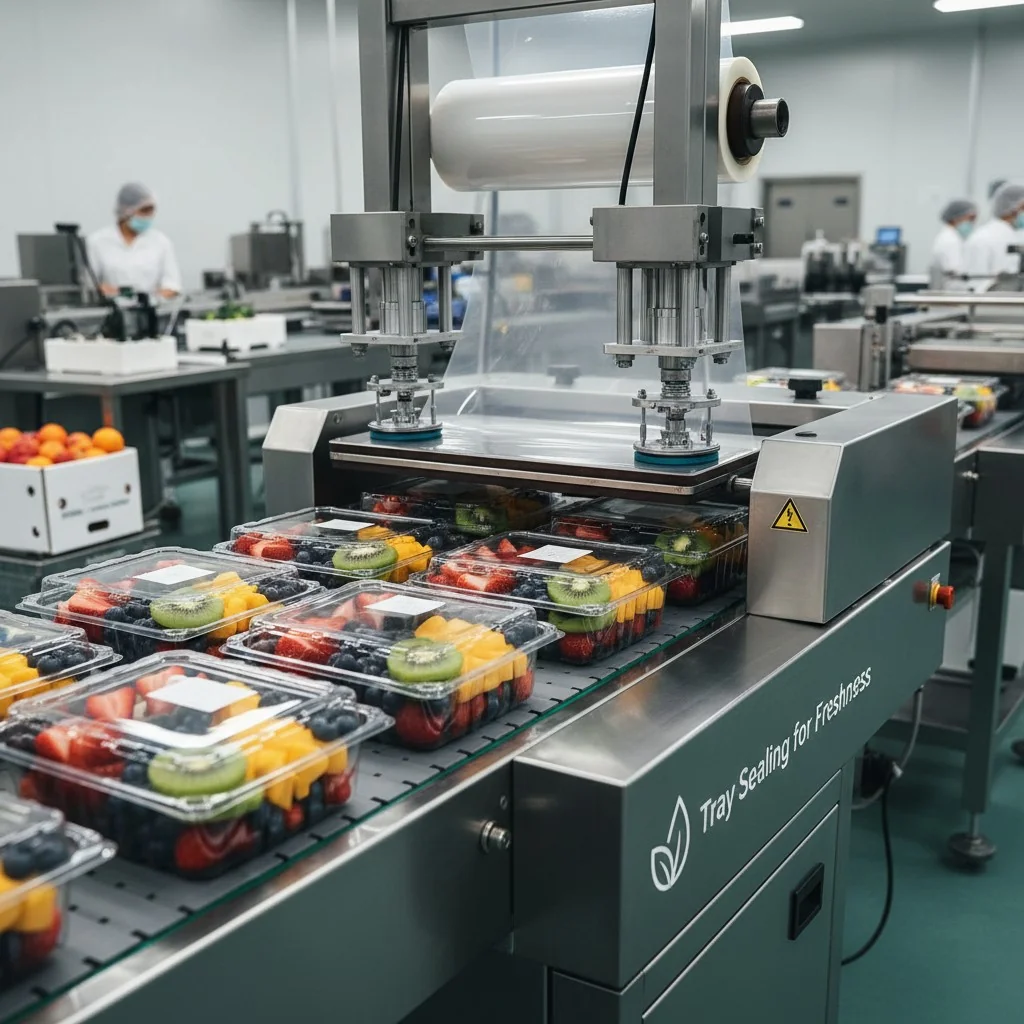Are you struggling to balance hygiene, functionality, and cost in your fresh food packaging machine designs? Many designers face the same dilemma.
As someone working in this field, I know the core challenge: delivering innovative, efficient, and food-safe solutions for large-scale production. It’s about more than just aesthetics; it’s about performance and compliance.

I’ve seen firsthand how crucial it is to address these design hurdles effectively. From concept to reality, every choice impacts the machine's overall success and the safety of the food it handles.
How Can We Future-Proof Fresh Food Packaging Machine Design for Hygiene?
Are you worried your current designs might fall short of evolving hygiene standards? Staying ahead means integrating robust, proactive measures into every design.
Future-proofing fresh food packaging machine design for hygiene involves adopting principles like Clean-in-Place (CIP) compatibility, eliminating hard-to-clean crevices, and selecting advanced antimicrobial materials, ensuring compliance with future food safety regulations.

I’ve had many conversations with our R&D team at XIAOSEN PACK about what truly makes a machine hygienically sound for decades to come. It’s not just about meeting today's standards. It’s about anticipating tomorrow's.
What are the key principles for hygienic design?
Hygiene in fresh food packaging machines starts with the very first sketch. We must plan for easy cleaning and preventing contamination. Our designs focus on smooth surfaces. They avoid sharp angles where food particles can get trapped. I think about materials all the time. Stainless steel (304 tai 316 grade) is standard. It resists corrosion. It does not react with food. We also use food-grade plastics where appropriate. These choices help stop bacteria from growing. They make cleaning cycles more effective. Every bolt and every seam matters. We want to remove all hidden spots. These spots could harbor microbes.
| Principle | Description | Impact on Hygiene |
|---|---|---|
| Material Selection | Non-absorbent, non-toxic, corrosion-resistant | Prevents bacterial growth, ensures food safety |
| Surface Finish | Smooth, polished, crevice-free | Easy to clean, prevents food particle entrapment |
| Accessibility [image placeholder] | Parts are easy to reach for inspection and cleaning | Reduces cleaning time, ensures thorough cleaning |
| Drainability | Sloped surfaces, no standing water | Eliminates moisture build-up, prevents microbial growth |
| No Product Contact Zones | Clear separation of food contact and non-food contact parts | Prevents cross-contamination |
Why is Clean-in-Place (CIP) important?
Clean-in-Place (CIP) is a big deal for hygiene. It lets us clean the machine without taking it apart. This saves a lot of time. It also makes cleaning more consistent. The machine has spray nozzles and pipes. These deliver cleaning solutions and water to all surfaces. Our engineers design the internal pathways to be smooth. They make sure the cleaning fluid reaches everywhere. This means no manual scrubbing is needed inside. It also means fewer chances for human error. We at XIAOSEN PACK prioritize CIP compatibility. It boosts uptime. It also reduces labor costs for our clients. This shows our commitment to both efficiency and food safety. I often think how this directly impacts product integrity on the shelves.
Is Balancing Cost and Performance in Fresh Food Packaging Machine Design a Myth?
Do you ever feel like you have to choose between a high-performing machine and an affordable one? Many believe achieving both is impossible.
No, balancing cost and performance in fresh food packaging machine design is not a myth; it requires smart material selection, modular design, and efficient manufacturing processes to deliver robust, effective solutions within budget constraints.

I’ve spent years at XIAOSEN PACK working to debunk this myth. It’s not about cutting corners. It’s about smart engineering and understanding the entire production lifecycle.
How do material choices impact both cost and performance?
Material choices are central to cost and performance. I look for materials that give the best value over time. Stainless steel is often more expensive at first. But its durability means less maintenance. It also means a longer machine life. This lowers the total cost of ownership. Sometimes, we can use advanced composites or high-performance polymers. These might be lighter. They can offer specific benefits, like better insulation or noise reduction. They are also cost-effective in the long run. We might use them for non-food contact parts. This helps to optimize the overall machine cost. At XIAOSEN PACK, we analyze each component. We match the material to its function. This ensures we get the right performance without overspending.
| Material Type | Initial Cost | Performance (Hygiene, Durability) | Long-term Value | Example Use |
|---|---|---|---|---|
| Stainless Steel | High | Excellent | Very High (low maintenance) | Food contact surfaces, frame |
| Food-Grade Plastic | Medium | Good (specific applications) | Medium-High | Conveyor belts, specialized components |
| Aluminum | Medium | Good (non-food contact) | Medium | Housing, structural elements (non-food) |
| Ceramics | Very High | Excellent (specific functions) | High | Bearings, specialized wear parts |
Can modular design truly reduce costs without sacrificing quality?
Modular design is a game-changer. It means we build machines from standard, interchangeable parts. I love this approach because it directly helps cost. It speeds up manufacturing. We can mass-produce these modules. This lowers their individual cost. It also makes maintenance easier. If one part breaks, we just replace that module. We do not need to replace the whole machine. This reduces downtime for our clients. It also lowers their repair costs. For customization, we can mix and match modules. This meets specific client needs without starting from zero. At XIAOSEN PACK, we use modularity. It gives us flexibility. It keeps quality high. It also keeps prices competitive. This strategy really helps balance cost and performance.
Is Sustainable Packaging Integration More Than Just a Trend?
Are you wondering if incorporating sustainable packaging into machine design is just a passing fad or a deep-rooted necessity? Many are still unsure of its long-term impact.
Yes, sustainable packaging integration is much more than a trend; it is a critical necessity driven by consumer demand, regulatory pressure, and the imperative to reduce environmental impact, requiring machine designs that accommodate recyclable, compostable, or reusable materials.

I often discuss this with Jacky and our product design team. At XIAOSEN PACK, we see sustainability as a core part of our mission. It’s about building machines that support a healthier planet.
How do machine designs adapt to new sustainable materials?
Adapting machine designs for sustainable materials is complex. Sustainable films, for example, often behave differently. They might be thinner or less rigid. They could need lower sealing temperatures. They might require special handling. Our designers must adjust the machine’s grip systems. We sometimes need new heating elements. Sensor technology becomes more important here. It helps monitor the material as it moves through the machine. This ensures perfect seals. It also prevents tearing. At XIAOSEN PACK, we run extensive tests with new materials. We refine our designs. This makes sure our machines can handle these greener options. I believe this adaptation future-proofs our clients' operations.
| Material Type | Machine Adaptation Needed | Edut | Challenges |
|---|---|---|---|
| Recyclable Plastics | Optimized heating/sealing, precise tension control | Reduces landfill waste, consumer friendly | Material rigidity, sealing temperatures |
| Compostable Films | Gentle handling, specific heat and pressure settings | Biodegradable, reduces plastic pollution | Fragility, shelf life, cost |
| Paper-Based Solutions | Robust feeding, specialized folding/sealing | Renewable resource, consumer preference | Moisture sensitivity, barrier properties |
| Reusable Containers | Automated handling, cleaning, inspection units | Significant waste reduction | Logistics, sanitization, initial investment |
What regulatory and consumer demands drive this sustainability push?
Consumer demand for sustainable packaging is huge. People want eco-friendly options. They are looking for brands that care about the environment. This pushes companies to change. Also, governments are setting new rules. They want less plastic waste. They want more recycling. These regulations impact our machine designs directly. We must make sure our machines can work with compliant materials. At XIAOSEN PACK, we keep up with these trends. We help our clients meet these new demands. This means building machines that can handle new, greener packaging. I see this as a big step forward for the entire industry. It’s not just about selling machines. It’s about helping build a better future.
Conclusion
Designing fresh food packaging machines demands balancing hygiene, cost, and sustainability. By focusing on cleanability, smart engineering, and material adaptability, we deliver solutions that meet current needs and prepare for future challenges.
